
Scrambled Turtle Eggs for Sex?

The following photographs of turtle eggs being taken, probably to be sold as aphrodisiacs, will no doubt make any conservation-minded person sick. They were taken at the beach at Ostional on Costa Rica’s Guanacaste Peninsula.
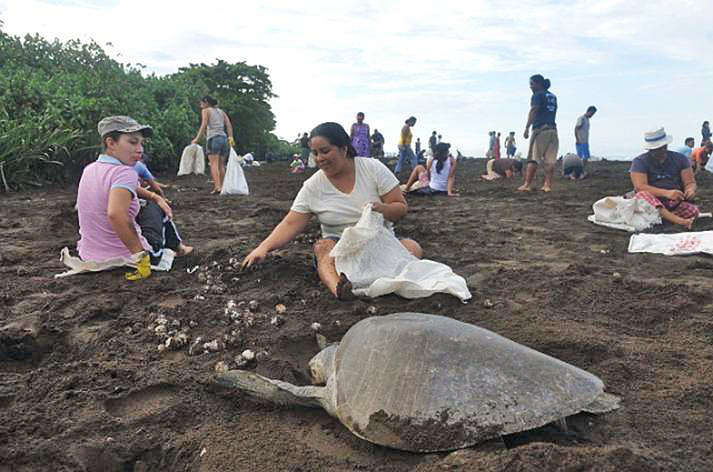
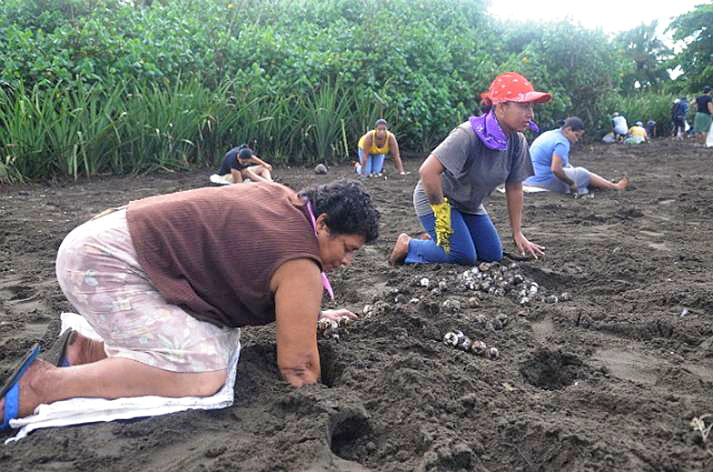
But according to the Hoax-Slayer internet site, and others, it’s actually a Costa Rican government-sponsored conservation effort, and it’s protecting the olive Ridley turtles. It sounds contradictory, doesn’t it?
Way back in ’98, National Public Radio correspondent John Burnett tried to explain it:
The age-old belief in the aphrodisiac power of turtle eggs sustains a thriving black market for the forbidden ovum throughout Latin America. Most countries have banned the collection of these eggs because the world’s eight sea turtle species are endangered by disease, incidental capture in fishing nets, disturbance of nesting areas, and poaching of eggs and turtles. But in the coastal town of Ostional, located on Costa Rica’s Guanacaste Peninsula, a 13-year-old project has helped stabilize the population of the olive Ridley sea turtle. The government has, in essence, legalized poaching.
For 10 months of the year, usually around the third quarter of the moon, olive Ridleys swim by the hundreds of thousands to a single mile of beach at Ostional in an ancient reproductive rite little understood by scientists. They scuttle onto the sand, dig a hole with their flippers, and drop in an average of 100 leathery, white eggs the size of ping pong balls. Over the course of a five-day "arribada," literally, an arrival, nesting females will leave as many as 10 million eggs in the black, volcanic sand. Mass nesting is nature’s way of ensuring that after the turkey vultures, feral dogs and raccoons have eaten all the fresh eggs they want, there will be enough left over to produce a sustainable population of olive Ridleys.
In the early 1980s, scientists learned that because of limited space on the beach, females arriving later destroy the first laid eggs. The researchers wondered: why not let poachers have the doomed eggs?
"What we have done is turn people into predators," says Dr. Anny Chavez, a sea turtle biologist and one of the founders of the Ostional project, which is world famous among turtle activists.
Under a law written especially for Ostional, the government allows an egg harvesting cooperative to collect all they can during the first 36 hours of every ‘arribada’. Co-op members then truck the eggs around the country, selling them to bars and restaurants. In return, the community must protect the olive Ridley. Co-op members clean debris from the nesting areas and patrol the beach day and night for poachers."
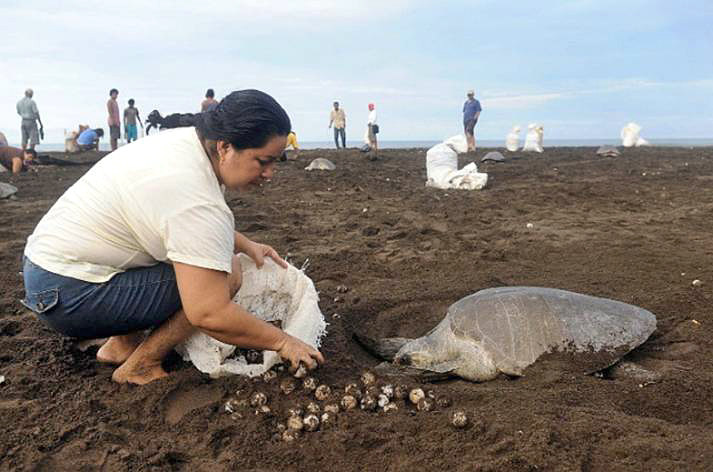
An article about the olive Ridley turtle published on the Ocean Actions seemed to support this:
The capacity of the half-mile Ostional beach is insufficient for the large number of nesting turtles and as a result many clutches are destroyed in the nesting process. As thousands upon thousands of olive Ridley turtles climb on to a stretch of Playa Ostional, 70-80% of previously laid nests are crushed or dug up during the subsequent nesting. It is for this reason that the Egg Harvest Project is justified. Villagers wait and watch, harvesting the eggs laid in the first day and half of the ‘arribada’.
Over the years this practice has proven to increase the percentage of successful hatching by as much as 20%. Assessing a sea turtle population is a challenge, but nesting data in Ostional indicate a stable population. A major contribution to the success of the Egg Harvest Project is the lack of decomposing eggs. If left unharvested, the early nests that are destroyed by later nesting females act as a source of bacteria that can contaminate the later nests.
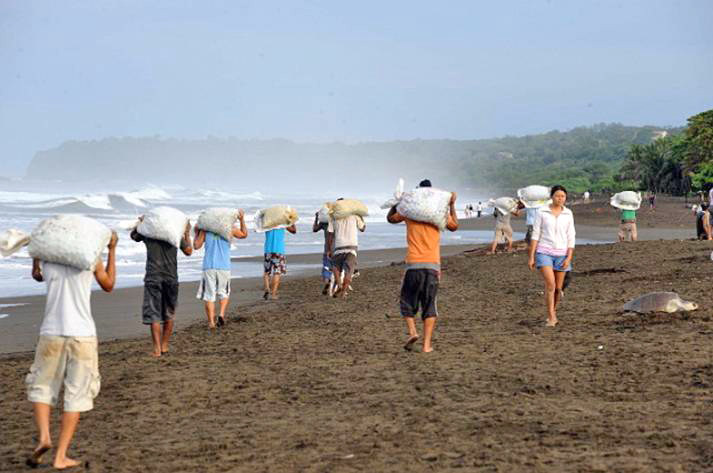
We’re not experts on conservation or turtles, but it seems to us there is a giant hole in this logic. If the villagers collected the early eggs for nurturing and eventual hatching, as opposed to selling them in bars and restaurants as some kind of natural Viagra, it seems to us that the live Ridley turtle population might soar as opposed to merely remaining stable. Then, too, in Third World countries where poverty and corruption are endemic, it seems to us that the foxes have been put in charge of the henhouse.
So what do you think? Email your thoughts to Richard.
Is SF’s Cup Bid on Shaky Ground?
With its government having pulled out all the stops to put togther a bid to host the 34th America’s Cup, San Francisco is far from a lock to host the event. Most recently, reports that BMW Oracle Racing team officials have been meeting with representatives from Newport, Rhode Island, Dubai, and a nebulous Italian venue have done a great deal to cast doubt on San Francisco’s bid. Given that the team’s imposed deadline for a bid from the City has already passed, we’re at a loss as to what the team hopes this will accomplish. It’s too late to be a negotiating ploy, which leads us to believe that all the effort put in by the sailing community, San Francisco government and civic leaders may have been in vain all along.
First of all, what’s with all this Newport, Rhode Island business? What happened to San Francisco being the only U.S. city under consideration? Ellison can do what he wants with the Cup — it’s his perogative as the winner — but he’s going to have a hard time arguing that the signed, sealed and delivered deal from the City of San Francisco will have a deleterious impact on the event. Which is the only believable argument from someone with a personal fortune estimated in the neighborhood of $27 billion. He’s going to have a hard time convincing us that Newport will generate the same kind of international appeal and enthusiasm around the Cup as San Francisco will.
The thing is, by this point in the process, San Francisco is a known quantity. Ellison and Coutts know what they’ll get here, the terms are spelled out. It seems highly doubtful that Rhode Island, motivated as it is to get the event, would be able get a host city agreement together and voted on by the end of the year. So, if they were to choose Rhode Island, BMW Oracle Racing either must risk announcing the venue without having a host city agreement in place, or put off the venue announcement and risk being sued by a challenger for not sticking to the protocol.
The team’s COO Stephen Barclay has been all over the wires with his claims that the deal was changed late in the game and that’s what caused the team to look elsewhere. But the reality is that the deal only changed because the original one no longer had the support of the majority of Board of Supervisors, due in part to the fact that the City government rightly uncovered the myth the team made every effort to perpetuate — that of the bogeyman Italian venue (while the European economic crisis swelled to a crescendo) — and that even if that competition was real, it wasn’t worth giving away the farm for anyway.
Ellison and company kept pitching the importance of an incentive — it’s still there in the revised deal, by the way — to bring the 34th Cup to the Bay. But nowhere was there any call to create an incentive for the team to keep it here. For instance, tying the length of the leases on Piers 30/32 and Seawall Lot 330 into the future editions of the Cup, which is an incentive that would seem fair to us.
The truly wrenching thing about the whole state of affairs is that the format and the boats are so brilliant, so inspired and so necessary that there’s not much we can find fault with in the vision that Coutts and Ellison are trying to execute. But what we can’t understand is, why not have the most radically progressive and innovative America’s Cup in history in a milieu that radiates those qualities? If Ellison wants to have it here, he can have it here. He won’t lose a ton of money to put on the regatta with the deal he has before him. Like it or not, we’re about to find out what his primary motivation has been all along.
Photoshopped or Authenic, You Tell Us
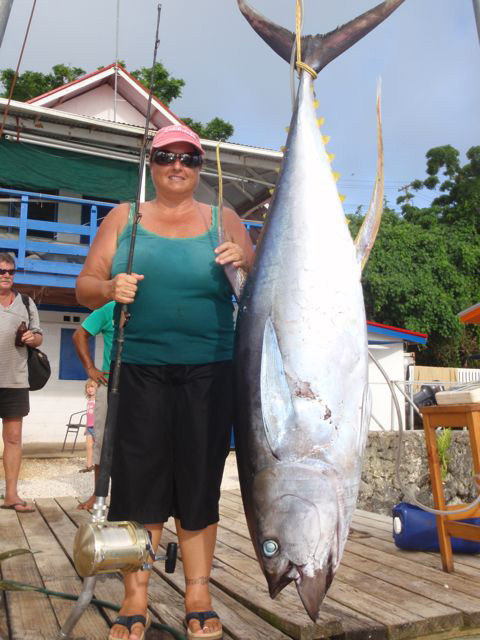
As you might imagine, here at Latitude 38 World Headquarters we receive all sorts of crazy stuff by email — and we’re not just talking about Nigerian inheritance scams, artificial hip recalls, and web specials on oxycodone.
For example, take this photo of a former San Diego sailor named Brenda. We can verify that she now lives in the tropics where she might conceivably catch big pelagic fish like yellowfin tuna. But come on, a tuna that’s two feet taller than the gal who supposedly caught it? Sounds a little fishy to us. But then, regular readers will recall that we said the same thing back in May when we saw a photo of Ethan ‘Enzo’ Smith of the Ovni 36 Eyoni holding a massive pargo that he’d reportedly speared while free-diving in Mexico — and that photo turned out to be real.
So what do you think: Is Brenda’s tuna photo authentic or could it be that she has been messing around with Photoshop software in her spare time? Give us your vote by email and we’ll tell you the truth in our next posting. And while you’re at it give us you’re best caption or title for this shot. (Our favorite suggestion will win some official Latitude swag.)
